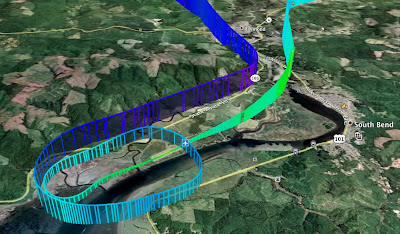Through some research I found an instructor at PHNL (Mike Richards...who is excellent) and agreed to meet him on Friday after my workday was finished. We used his Cessna 172N (N5660E), which is the same species as N75898, though without the 180hp upgrade to the engine. So I was already pretty familiar with the aircraft, though every plane's avionics are a bit different and it took a few minutes to get oriented.
PHNL is in Class B airspace (like KSEA), with a few extra rules and procedures. The first difference is that VFR aircraft require an explicit clearance to enter the airspace, rather than just establishing two-way radio contact as at KOLM. So after completing our preflight and orientation, Mike had me call up the delivery frequency for clearance. I had studied the standard VFR departure procedures, and requested the Shoreline Four departure, which calls for a climb to 1500 and an immediate right turn after departing runway 4R/4L, then staying about a mile offshore past downtown Honolulu, Waikiki, and Diamond Head. The clearance delivery controller granted the request, then had us switch to ground for taxi.
Though ground originally assigned us runway 4R, when we called the tower holding short, she reassigned us to 4L and had us "line up and wait" (first time I'd ever been issued that clearance!) So we taxied onto 4L and watched a couple of big jets depart on runway 8L, which crosses 4L downfield. Finally it was our turn to go, with caution for wake turbulence from the Alaska 737 that had just departed 8L, and for the helicopter that had just departed the ramp behind us.
 |
| Taxi route and takeoff from runway 4L. Runway 8L from top-left to right-center |
We turned right offshore, and out the left-seat window I had a great view of Honolulu and Waikiki, then Diamond Head and Koko Head. Just after we passed Diamond Head, the approach controller cleared us to climb on course...which was to Molokai (PHMK), 25 miles to the south over the Kaiwi Channel. The crossing at 3500' went much more quickly than I thought it would, despite my checking every 30 seconds to make sure the oil pressure and temperature were right in the middle of the green, and RPM was right where I left it. Mike had reviewed the overwater emergency kit with me during preflight, but I really hoped not to have to use it!
The view as we approached the north coast of Molokai was spectacular. It's a very rural place, with stunning cliffs and beaches and not a lot of human development. It's also a small island, so 5 minutes after crossing the shoreline, I contacted the tower (PHMK is a Class D field), setting up for a right downwind entry to runway 23 as instructed. I was a little high on final--my excuse was beautiful scenery and an unfamiliar airplane--but the runway is long and I salvaged a decent landing. A left crosswind departure followed, and a few minutes later we were over the south shore for another crossing--to Lanai.
The airport on Lanai (PHNY) is on the southwestern part of the island, just over the top of the rapid upslope from the north shore. It is fairly high, at 1300', and right in the midst of a turbulent rotor layer from the northeastern trade winds flowing over the peak of the old volcanic cone. There was quite a lot of rough air the whole way across the island, including in the pattern, but it smoothed out on final as I accomplished a nice touch-and-go landing on runway 3.
After the visit to Lanai, we climbed back to the northwest, headed back to Honolulu. We had to dodge around several cloud layers west of Lanai, but after that we were treated to smooth air and a beautiful central Pacific sunset. We requested radar vectors for runway 4R, which allowed for some good IFR practice.
 |
| Entire flight route |
To say this was an amazing experience, with spectacular scenery and very fun flying, would be an understatement. I accomplished several firsts: takeoff and landing at a Class B airport, flying over water outside gliding distance from shore, three new airports, two new Hawaiian islands visited... A very rewarding couple of hours in the air.
Google Earth track is here.










